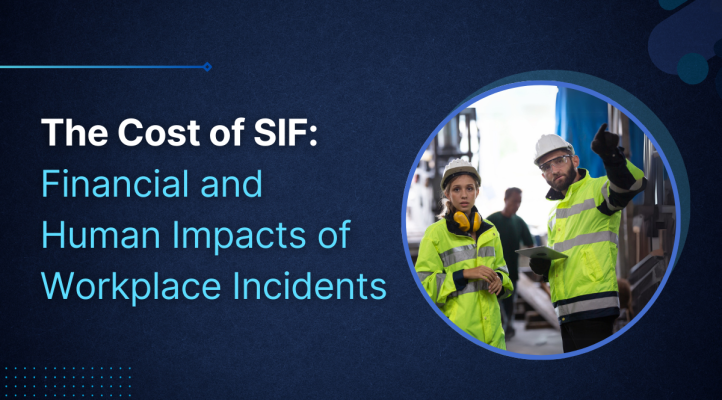The True Cost of SIF: Lives, Liability & Loss

Every workplace carries inherent risks, but some incidents have far more significant consequences than others. When a company experiences a serious injury, it creates both human and financial impacts. The human impacts can be felt from the boardroom to the floor level. The economic costs impact the bottom line both directly and indirectly. Capturing Serious Injury and Fatality (SIF) data incidents helps organizations understand where the potential exposure for a serious injury is to occur so that risk can be avoided.
Understanding the actual cost of serious incidents allows organizations to comprehend why the focus of SIF can also play a critical role in cost avoidance. OSHA’s Safety Pays web page provides a good tool for estimating costs based on injury type. When considering a serious injury such as an amputation and using their OSHA calculator tool, the indirect and direct costs for a single injury amount to over $200,000 per incident. To put this into revenue terms, maintaining the same bottom-line profit would require generating at least an additional $9M in revenue to offset these costs.
The Direct and Indirect Costs of SIF Incidents
Direct Costs: The Immediate Financial Impact
Direct costs are the most visible financial consequences of SIF incidents. These expenses arise immediately after an accident and include:
- Medical Expenses: Emergency care, hospitalization, rehabilitation, and long-term medical treatment for injured employees can lead to significant costs, ranging from $200,000 to over $1,000,000 per incident.
- Workers’ Compensation Claims: Businesses must cover workers’ compensation and wages, which increases with the severity of the injury or fatality and often costs between $150,000 and $2M+ per case.
- Regulatory Fines and Penalties: Organizations may face hefty fines, sometimes exceeding $150,000 per violation, if an incident violates OSHA or other regulatory guidelines.
- Legal Expenses: Lawsuits from employees or their families can lead to costly settlements and legal fees, with some cases costing between $500,000 and $5M+.
- Insurance Premium Increases: Frequent or severe workplace incidents result in higher insurance costs.
- Physical Modifications: The severity of an incident can require physical modifications, such as equipment upgrades or property damage repair.
Medical expenses, workers’ compensation claims, regulatory fines, legal settlements, and insurance premium increases quickly add up. Depending on the severity and circumstances, the total direct cost of a single SIF incident will typically be over $1M. These costs alone can place a substantial financial burden on companies, making proactive safety measures critical to minimizing risk and reducing financial liabilities.
Indirect Costs: The Hidden Business Burden
While direct costs are substantial, the indirect costs of SIF incidents often have an even more significant long-term impact on businesses. They typically range from four to ten times higher than the direct costs. These include:
- Lost Productivity A serious injury or fatality can halt operations, leading to delays, missed deadlines, and decreased efficiency.
- Training and Replacement Costs: Businesses must recruit, hire, and train new employees to replace injured workers, which adds significant overhead.
- Reputational Damage: A workplace incident can erode trust among customers, stakeholders, and prospective employees, potentially affecting future business opportunities.
- Decreased Employee Morale: Workplace incidents create an environment of fear and anxiety, leading to disengagement and lower productivity.
- Operational Disruptions: Investigations, safety audits, and corrective actions consume time and resources, diverting focus from business growth.
Since indirect costs are estimated to be four to ten times higher than direct costs, total SIF costs will be significantly higher. These hidden expenses can quickly escalate, leading to financial strain, operational disruptions, and long-term damage to a company’s reputation.
The Human Impact of SIF Incidents
Beyond financial consequences, workplace incidents take a significant toll on individuals and their communities. Employees who suffer serious injuries may experience long-term disabilities, emotional trauma, and economic hardship. Families of affected workers endure stress and uncertainty, especially when the injured employee is the primary breadwinner.
Coworkers who witness or are impacted by such incidents may struggle with anxiety, reduced trust in workplace safety, and lower morale. A company’s culture and commitment to safety play a crucial role in mitigating these effects. Proactive safety measures, mental health support, and leadership engagement help reassure employees and foster a secure work environment.
How Rhythm Innovations Can Help
Rhythm Innovations offers digital solutions to help businesses efficiently prevent and manage SIF incidents. Our platform provides:
- Real-Time Safety Monitoring: Track workplace hazards using data-driven insights and automated alerts.
- Automated Compliance Management: Streamline safety reporting and regulatory tracking to stay compliant.
- Incident Analysis and Prevention: Use predictive analytics to identify risks and prevent accidents.
- Risk Mitigation Planning: Leverage data insights to develop proactive safety strategies.
By adopting Rhythm Innovations’ solutions, businesses can enhance workplace safety, reduce costs, and create a more secure workplace.
Conclusion
SIF incidents are more than costly; they pose serious risk to employee well-being and business stability. The financial burden, reputational damage, and productivity loss can set companies back for years. By prioritizing proactive safety measures and leveraging technology-driven solutions, businesses can create a safer workplace, reduce liabilities, and protect their workforce. Investing in prevention today ensures a stronger, more resilient organization for the future.
Contact Rhythm Innovations today to implement cutting-edge safety solutions and create a safer, more secure, and productive workplace for your employees.


